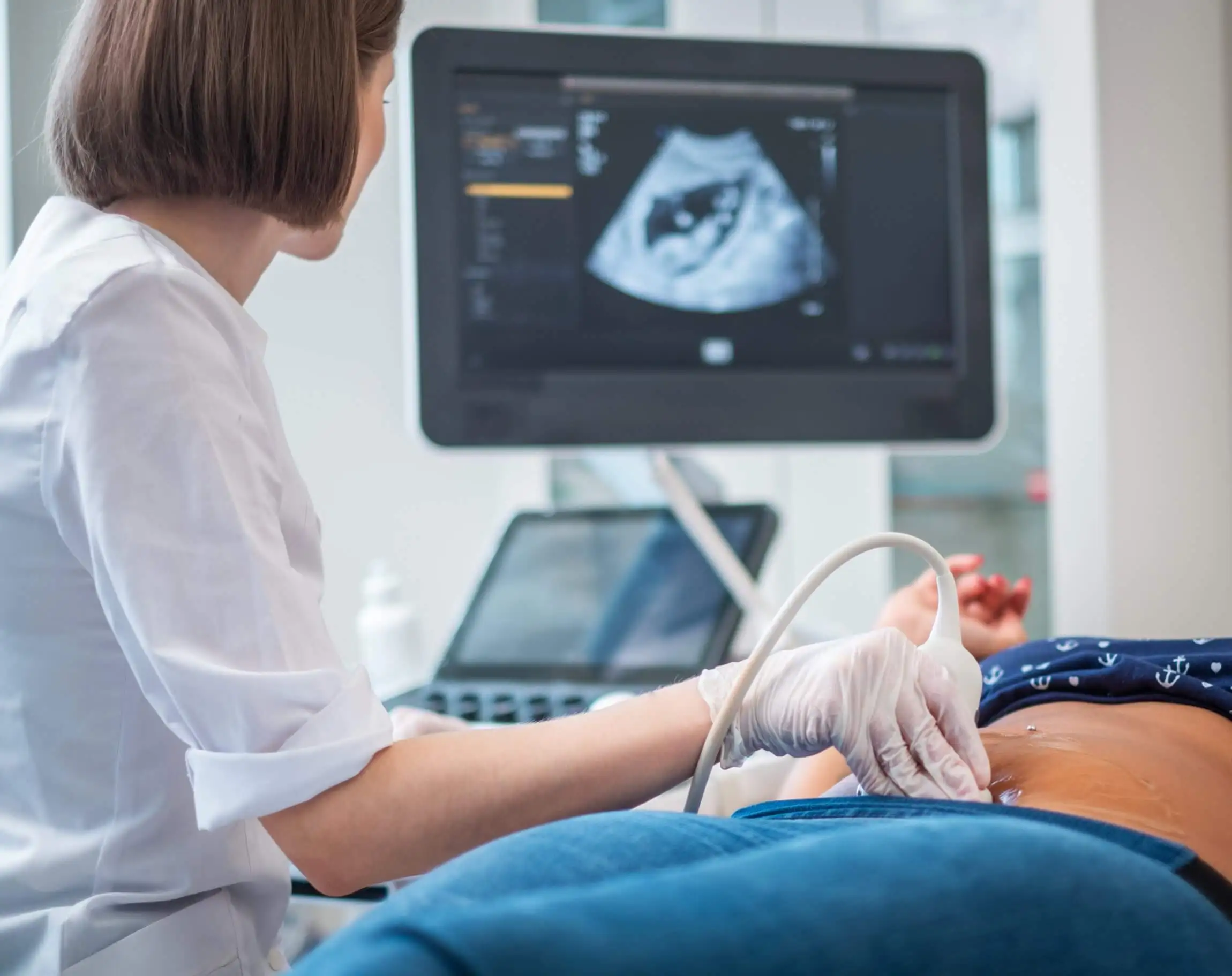What Is a Threatened Abortion and Why Does it Occur?


Reviewed and approved by the doctor Diego Pereira
A threatened abortion, as the name implies, is a warning that a miscarriage may occur during the course of pregnancy. A miscarriage is defined as the interruption and premature termination of the pregnancy.
A threatened abortion or misscarriage usually occurs before 20 weeks gestation. Although in some cases it may simply remain an incidence and the pregnancy continues under normal conditions, in many other cases it does end as a complete miscarriage.
That is why it’s essential to recognize the signs and symptoms of this problem. So in this article, you’ll find everything you need to know about threatened miscarriage.
What is a threatened abortion?
A threatened abortion is a warning. As an article in Assisted Reproduction explains, this threat suggests that a miscarriage may be imminent.
Miscarriage occurs involuntarily – that is, without any intervention to provoke it. Unfortunately, this is a fairly common occurrence.
It’s estimated to occur in 15% of all pregnancies, according to epidemiological data.
Although in many cases the exact cause is not determined, it’s known that certain factors increase the risk of miscarriage. For example, age. The older a woman gets, the higher the likelihood of a miscarriage.
However, threatened miscarriage doesn’t necessarily have to culminate in a miscarriage as such. However, this is a situation that should be addressed urgently to try to avoid such an outcome.
What are the associated symptoms?

We think you may be interested in reading this, too: Your First Visit to the Gynecologist During Pregnancy
A threatened abortion manifests itself with a variety of symptoms that are important to identify. It doesn’t always culminate in miscarriage.
As explained in an article by Stat Pearls the most common symptom is vaginal bleeding. It can be more or less heavy bleeding, with or without clots. It appears before 20 weeks gestation.
In many cases, the bleeding comes from hematomas inside the uterus. These hematomas can cause the placenta to detach from the uterine walls. According to a 2014 study, the risk is notorious in pregnancies of less than 20 weeks, but after that, hematomas don’t seem to affect birth outcomes.
Another very common sign is pain. It usually appears in the lower abdomen and resembles menstrual cramps. Many women also experience pain in the lower back, which is accompanied by pins and needles.
In a threatened abortion, the cervix remains closed and the fetus is still alive inside the uterus. Since it occurs in the first trimester of pregnancy, the typical symptoms of pregnancy may be mitigated or disappear.
A threatened abortion can lead to serious complications in addition to miscarriage as such. Anemia may occur if the bleeding has been heavy. It also increases the risk of infection in the mother.
Causes of threatened abortions
A threatened abortion or miscarriage, like a spontaneous miscarriage, can have multiple causes. This is a multifactorial problem, which is influenced by various aspects.
The miscarriage itself can be caused by maternal causes as well as placental or fetal alterations.
According to the MSD Manual, maternal causes include uterine or cervical abnormalities. For example, one of the most relevant is cervical insufficiency. This is when the cervix fails to remain closed and dilates in the early stages of gestation.
It can also be due to polyps, scar tissue, or myomas in the uterine cavity. Mothers suffering from chronic pathologies, such as diabetes mellitus, arterial hypertension, or thyroid disorders, are more at risk of miscarriage.
Similarly, antiphospholipid syndrome is considered to be another of the most common causes of miscarriage. Especially, of recurrent miscarriages after 10 weeks of pregnancy.
Other causes of threatened miscarriage are as follows:
- Chromosomal abnormalities of the fetus. Approximately 80 % of miscarriages during the first weeks are due to aneuploidy.
- Placental disorders, such as inadequate implantation.
- Anatomical malformations of the fetus.
Risk groups and risk factors
One of the factors that increase the risk of suffering a threatened abortion is the one we have previously pointed out: Advanced maternal age, since, as one age, the probability of abortion increases considerably.
In addition, any blow or injury occurring in or near the womb can also play a role. The same goes for infections, stress, or even certain medical treatments that are prescribed to the pregnant woman.
How is a threatened abortion diagnosed?

Like this article? You may also like to read: Why Do False Negative and False Positive Pregnancy Tests Occur?
Threatened miscarriage is usually quite obvious, because one of the main symptoms is vaginal bleeding. However, it’s essential to perform a series of complementary tests to check the status of the fetus and the condition of the pregnancy.
The first thing is an ultrasound. This can be done abdominal or transvaginal.
This test is used to check if the baby is still stable, as the heartbeat and its position can be determined. Similarly, a thorough examination of the mother and a vaginal examination is usually performed.
On the other hand, in most cases, a blood test is required. This test measures the levels of the human chorionic gonadotropin hormone. This is a substance that increases early in pregnancy and indirectly signals, if it remains elevated in the blood, that the pregnancy is continuing.
The test can also check for anemia or an active infection. It may be supplemented by a fetal well-being test in more advanced pregnancies.
Is there any treatment?
A threatened abortion is a complex situation. There is no specific treatment as such.
In cases where a miscarriage doesn’t occur, a number of actions are usually recommended to prevent it from happening again. The main idea is to maintain a healthy lifestyle, with a varied and complete diet. It’s recommended not to consume sausages or unprocessed meats, since they increase the probability of suffering certain infections (such as listeriosis).
Likewise, the mother should try to rest and not have sexual relations. In addition, substances such as alcohol and tobacco should be completely discontinued if they had not been eliminated from the habits before. The same goes for medications; nothing should be taken that has not been prescribed by a doctor.
As a Cochrane review explains, in some cases progesterone is administered during threatened abortion. This is a controversial treatment, as its efficacy has not yet been fully demonstrated.
However, it may be useful in women who have recurrent miscarriages in their medical history.
Tips for a healthy pregnancy
To try to prevent a threatened abortion or spontaneous abortion, optimal pregnancy conditions should be promoted. However, most cases of miscarriage cannot be prevented.
What you can do is act on modifiable risk factors. For example, you should avoid consuming alcohol, caffeinated beverages, and tobacco.
In addition, before becoming pregnant, ideally, there should be good control of any previous condition. In the case of women living with diabetes, high blood pressure, or obesity, it’s important to address these conditions before pregnancy.
The prenatal consultation is very important. A series of studies will be carried out and advice will be given on how to face pregnancy.
Although many cases of threatened abortion or miscarriage culminate in the loss of the fetus, this is not always the case. However, it’s a warning sign. That is why it’s essential to go to the doctor as soon as possible and follow all his or her recommendations.
All cited sources were thoroughly reviewed by our team to ensure their quality, reliability, currency, and validity. The bibliography of this article was considered reliable and of academic or scientific accuracy.
- Grande, C. S., Sánchez, L. V., Expósito, M. V., & Villanueva, M. G. (2017). Síndrome antifosfolípido. Medicine-Programa de Formación Médica Continuada Acreditado, 12(27), 1551-1559. https://www.sciencedirect.com/science/article/pii/S030454121730029X
- Lopez-Hernandez, D. (2020). Factores epidemiológicos de riesgo asociados al aborto espontáneo. Revista Internacional de Salud Materno Fetal, 5(4). http://ojs.revistamaternofetal.com/index.php/RISMF/article/download/193/223?inline=1
- Mouri, M., Hall, H., & Rupp, T. J. (2021). Threatened abortion. In StatPearls [Internet]. StatPearls Publishing. https://www.ncbi.nlm.nih.gov/books/NBK430747/
- Şükür, Y. E., Göç, G., Köse, O., Açmaz, G., Özmen, B., Atabekoğlu, C. S., … & Söylemez, F. (2014). The effects of subchorionic hematoma on pregnancy outcome in patients with threatened abortion. Journal of the Turkish German Gynecological Association, 15(4), 239. https://www.ncbi.nlm.nih.gov/pmc/articles/PMC4285213/
- Wahabi, H., Fayed, A., Esmaeil, S., & Al Zeidan, R. (2011). Progestágenos para el tratamiento de la amenaza de aborto espontáneo. Cochrane Database of Systematic Reviews, (12). https://www.cochranelibrary.com/cdsr/doi/10.1002/14651858.CD005943.pub4/es
- Xu, Q., Chen, J., Wei, Z., Brandon, T., Zava, D., Shi, Y. E., & Cao, Y. (2017). Sex hormone metabolism and threatened abortion. Medical Science Monitor: International Medical Journal of Experimental and Clinical Research, 23, 5041. https://www.ncbi.nlm.nih.gov/pmc/articles/PMC5665605/
- Zhou, J., Huang, Z., Pan, X., Leung, W. T., Li, C., Chen, L., … & Wang, L. (2019). New thoughts in exploring the pathogenesis, diagnosis, and treatment of threatened abortion. BioScience Trends, 13(3), 284-285. https://www.jstage.jst.go.jp/article/bst/13/3/13_2019.01155/_article/-char/ja/
This text is provided for informational purposes only and does not replace consultation with a professional. If in doubt, consult your specialist.








